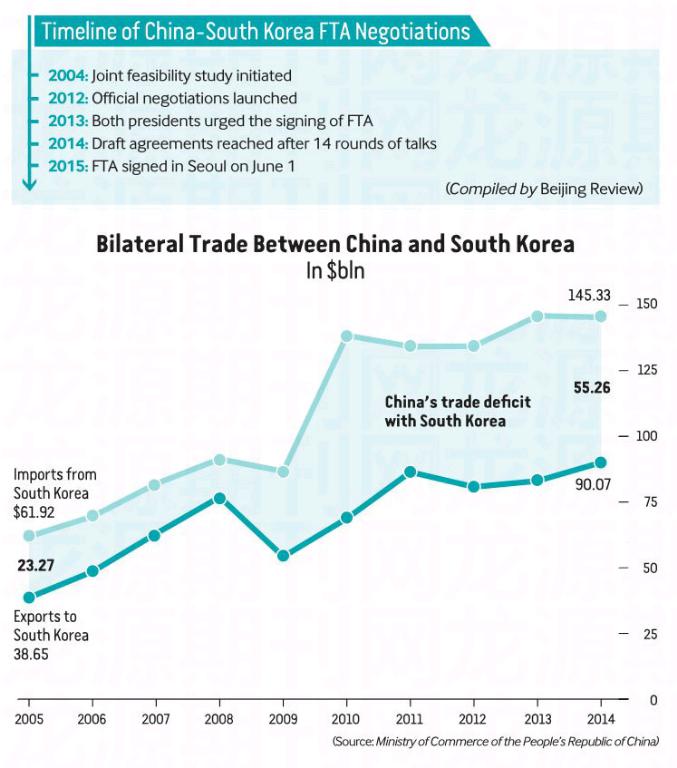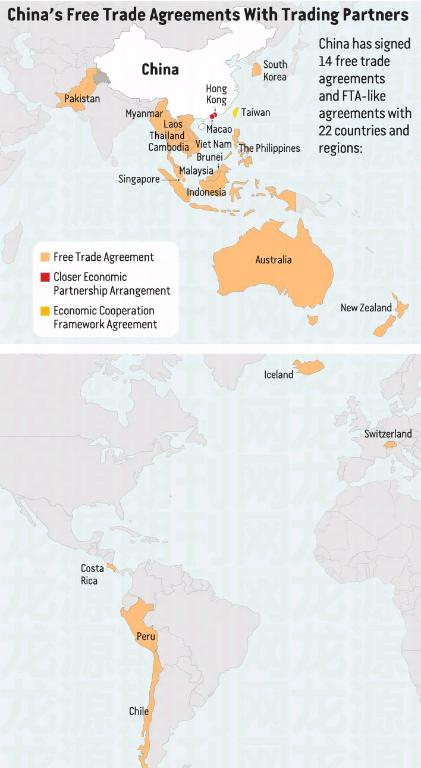Duty-Free Time Is Now
2015-07-13ByBaiShi
By+Bai+Shi
The signing of the China-South Korea free trade agreement (FTA) marks the beginning of an auspicious future—if everything goes as planned, the annual trade volume will double that of 2014 within the next five years.
It is the latest in a series of moves illustrating the economic relationship between China and South Korea, which grows closer by the day. China remains South Koreas largest trading partner, import country, export market and overseas investment destination. South Korea is Chinas third largest trading partner.
According to data released by Chinas Ministry of Commerce, Chinas trade with South Korea reached $235.4 billion in 2014, a huge jump in growth from $5 billion two decades ago when they first established diplomatic ties in 1992.
Chinese consumers continue to buy goods from South Korea in droves, including automobiles, cellphones, household appliances and—of course—the countrys famous cosmetics.
FTA highlights
The FTA deal with South Korea marks the largest bilateral trade agreement for China in terms of trade volume.
Zhuang Rui, Deputy Dean of the Institute of International Economy under the Beijingbased University of International Business and Economics, told Shanghai Securities News that the FTA deal covers the broadest range of trade in goods, services and investment, and aims at creating a beneficial environment for companies on both sides.
The most significant part of the trade agreement may be tariff elimination across the board. China will grant duty-free treatment to 91 percent of consumer and industrial products imported from South Korea, while the latter will eliminate its im- port duties on 92 percent of products from China over the next 20 years.
As for trade in services and investment, China, for the first time, promised to conduct negotiations by using the negative-list approach and adopting pre-establishment national treatment after the signed agreement takes effect.
The FTA covers 17 fields of trade and economic cooperation—conventional FTA clauses like goods and services trade, as well as 21st-century topics like intellectual property, e-commerce and the environment, Zhuang said. E-commerce and related cooperation were not included in Chinas previous FTA negotiations. The concepts will be tested on pilot cities, then extended.
Currently, free trade zones (FTZs) in Weihai City of east Chinas Shandong Province and Incheon of South Korea were chosen as pilot zones for cooperation.
“[The broad range covered by the FTA deal] reflects that the two countries commit to comprehensive market opening to each other,” Zhuang said.
The good and the tough
According to The Korea Herald, the countrys governing Saenuri Party supports the deal by acknowledging that the free trade agreement offers Korea a “second domestic market” that will improve the nations longterm economic prospects.
The Hankyoreh cited South Koreas governments assessment of the economic benefit of the FTA, which says South Korean real GDP will increase by an additional 0.96 percent, consumer welfare will improve by $14.6 billion, and 53,805 new jobs will be created within 10 years of the agreement taking effect.
In the eyes of many Chinese, such broad range of products and services which are granted zero tariff status in the FTA deal will challenge the Chinese economy.
Under the current trade structure, most Chinese goods exported to the South Korean market are low value-added products like raw materials and agricultural products. On contrary, goods from South Korea are mainly industrial and technological products with high added value.
But Zhuang claimed the deal will not compromise Chinese companies, stating, “China and South Korea usually exchange similar products belonging to the same industry.”
By eliminating tariffs, the deal will reduce costs for both Chinese and South Korean producers and sellers, benefiting the two sides involved, Zhuang said.
However, Mei Xinyu, a researcher at the Chinese Academy of International Trade and Economic Cooperation (CAITEC) under the Ministry of Commerce, said that short-term changes are to be expected.
“In short run, the FTA deal might harm the interests of some of Chinas manufacturers that compete with South Korea, such as those making machinery, automobiles and electronics,” Mei said. “However, in the long run, the FTA is good for the growth of Chinese manufacturing.”
Mei explained that benefits will include Chinese-South Korean economic integration, better division of labor and—to Chinas ben- efit—the possible move of high-end industries from South Korea to the Chinese mainland.
Some analysts predict that the completed FTA deal will contribute 1 or 2 percent to Chinas GDP growth.
Zhao Jianglin, an international economics researcher at the National Institute of International Strategy under the Chinese Academy of Social Sciences, was confident that companies of both countries will be able to adapt themselves swiftly to the new system and competition in spite of a short-term clash of interests. Zhao said a transitional period was put in place in the hope of reducing the possible negative impact on producers and traders.
The opening of the South Korean market presents more opportunities for Chinas companies. For instance, Chinese delivery companies will be allowed to expand their business at an unprecedented scale in South Korea, including offering international air and maritime postal services, as well as nonexclusive local delivery services. Chinese construction companies will be allowed to contract projects, which will boost market shares and secure more profits. Chinese textiles and agricultural products will be able to acquire more market shares in South Korea as tariffs will drop drastically, and vice versa.
Unexpectedly, South Korean cosmetics, which have been popular with Chinese consumers, are not included in the catalogues of zero tariffs in the FTA.
Mei explained that cosmetics are neither daily necessities nor important raw materials, so it is unnecessary to give them duty-free treatment. Moreover, cosmetics made in South Korea have already enjoyed preferential tariffs—in China, the import duty on South Korean cosmetics is only 10 percent, or one 15th of the general tariff rate. The reason is that the two countries cosmetics trade is automatically granted most-favored nation treatment with the other as they are both WTO members.
“Some consumers are wondering why Korean cosmetics are still expensive. The key factor is not the tariff but cost of distribution and pricing policy of individual brand,” Mei said.
For Chinese consumers, the major benefits of the FTA deal include a price drop in consumer electronics and travel within South Korea, Mei said.
However, consumers expecting immediate and significantly lowered prices may need to remain patient. Zhu Zhenxin, macroeconomics researcher at the Research Institute of Minsheng Securities, said the process of granting zero tariff status will proceed in a step-bystep manner.
Other challenges like the rising renminbi exchange rate, the rebalance of global trade and increasing domestic labor costs should not be ignored, Zhu said. To ensure steady growth of exports, China needs to upgrade its industries and adjust its economic structure, Zhu said.
For greater integration
Seventeen days after China-South Korea FTA was reached on June 1, China signed a FTA with Australia. These agreements will not only lift the level of Chinas opening up by expanding current FTA establishments but also promote economic development in the East Asia region, Liang said.
Mei believed that the FTA deal is a major step for China to cement its strategy of economic integration with neighboring economies.
In the future, China and South Korea will establish a large common market covering a population of 1.35 billion and producing GDP worth $11 trillion.
With this large common market, the China-South Korea FTA will further help improve the international division of labor and upgrade manufacturing industries in East Asia region—and hopefully serve as a jumping-off point for future economic progress in the region and beyond. As Vladimir Petrovsky, a member of Russias Academy of Military Sciences, said in an article to Russia Beyond the Headlines, “the South Korean-Chinese FTA will most likely have an indirect yet positive impact on the Russian economy.” He also urged Russia to “join the talks on the creation of free trade areas and integration projects now, while the rules of the game are being elaborated, in order to guarantee its economic interests as best as possible.”
“The signing of the deal will be helpful to advance the slow-paced negations of FTA by China, Japan and South Korea, “said Zhuang,“as well as initiate talks on free trade areas in the Asia-Pacific.”
